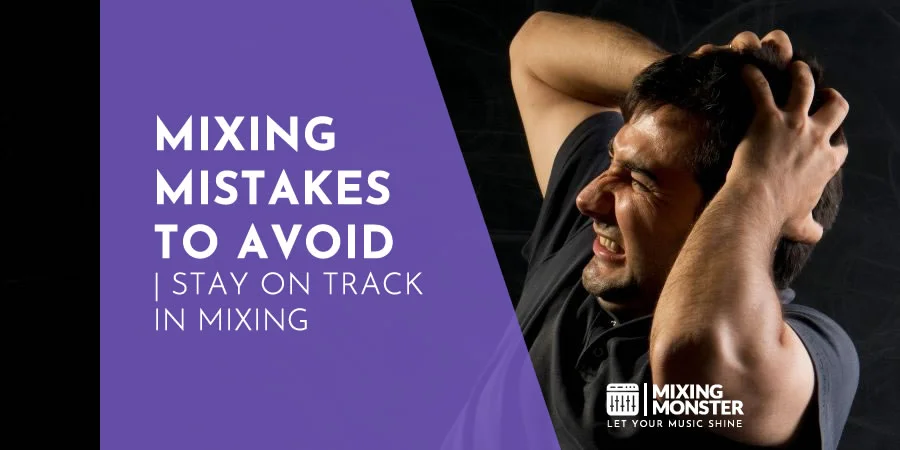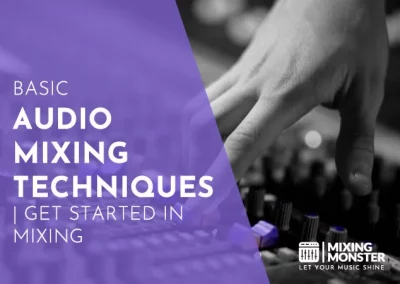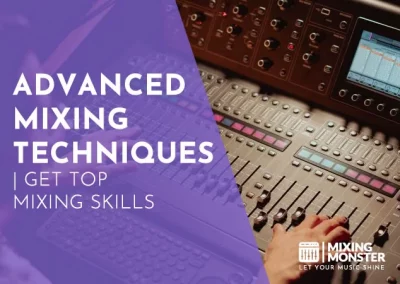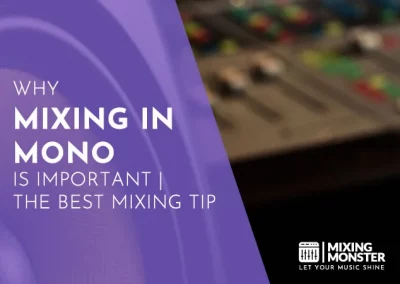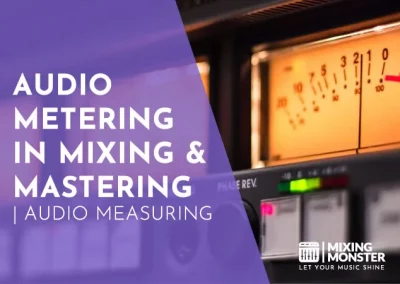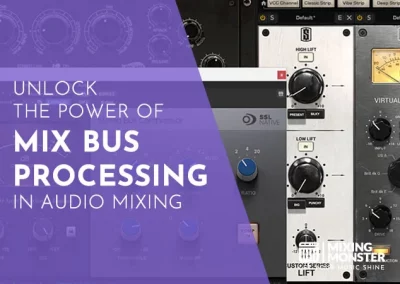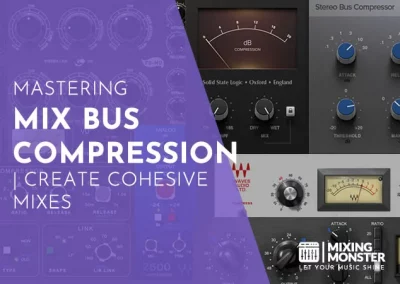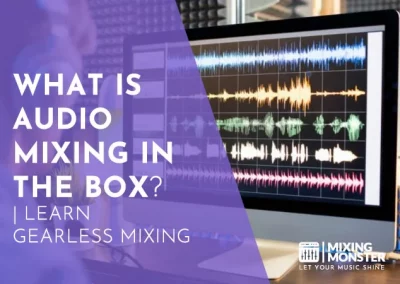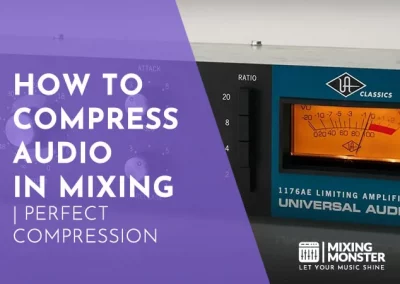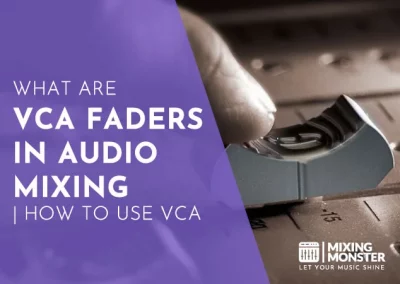Home > Blog > Mixing > Mixing Techniques
Disclosure: Some of the links below are affiliate links, meaning that at no additional cost to you, we will receive a commission if you click through and make a purchase. Read our full affiliate disclosure here.
Audio mixing can be as treacherous as rewarding—you’re tasked with blending individual stems into a cohesive whole. Unnoticed mistakes can quickly turn a promising track into a problematic one, making knowledge of common pitfalls imperative.
Audio mixing is an intricate process that involves balancing levels, equalizing frequencies, applying effects, and much more. It’s essential to identify the variety of potential errors that could occur—like over-processing with plugins, misunderstanding gain staging, or misjudging the spectral balance of a mix. Ensuring a clean, dynamic, and well-balanced mix demands keen ears and a thorough understanding of audio fundamentals.
In this article, you’ll learn not only about the top audio mixing mistakes to avoid but also how to rectify them in case they happen. Remember, a stellar mix is within reach, and knowing what traps to avoid brings you one step closer to achieving pristine audio productions.
KEY TAKEAWAYS:
- Knowing common mixing errors is crucial for a clean mix.
- A comprehensive approach to mixing helps avoid and fix mistakes.
- Continuous learning is vital to improving your audio mixing skills.
Table Of Contents
1. Understanding Audio Mixing Mistakes
2. Top Audio Mixing Mistakes to Avoid
3. Best Practices For Avoiding Mixing Mistakes
4. Correcting Audio Mixing Mistakes
5. Consequences Of Unaddressed Audio Mixing Mistakes
6. Future-Proofing Your Mixes
7. Stay On Track In Audio Mixing
8. FAQ

1. Understanding Audio Mixing Mistakes
Your mixing decisions can make or break the final track in audio production. Understanding the pitfalls is crucial for achieving a clean and professional sound.
Definition Of Audio Mixing Mistakes
Audio mixing mistakes refer to errors made while combining multiple sound sources into a single audio track. These can range from technical oversights to creative misjudgments. For example, a common technical mistake is the improper balance of frequency levels, which can result in a muddy mix with a booming low-end.
Common Misconceptions About Audio Mixing
Many assume that louder is better, but overcompressing or driving the master bus too hot can lead to a fatiguing listening experience. Additionally, mixing in isolation without considering the context of the whole mix can create a disjointed track. Trends in technology and techniques evolve, yet adhering unquestioningly to them without understanding the basics can exacerbate beginner mixing errors.
2. Top Audio Mixing Mistakes to Avoid
In this section, you’ll discover common pitfalls that can undermine your mix and how to sidestep them. Mastery of these points ensures a more polished and professional sound.
Mistake 1: Mixing In Solo
When you mix in solo, you risk losing perspective on how individual tracks interact within the mix. Avoid using the solo button excessively; check how each element contributes to the whole.
- Explanation:
Isolating tracks can make them sound great individually but potentially clash in the full mix. - Consequences:
Loss of context and balance, leading to a disjointed mix. - How To Avoid:
Regularly switch between solo and full mix to ensure each track complements the others. Use solo sparingly for problem-solving, not for making broad-mix decisions.
Mistake 2: Over-Compression
While compression is vital for controlling dynamics, too much can squash the life out of your tracks. Use it judiciously to maintain energy and preserve transients that give the mix punch and clarity.
- Explanation:
Compression tames dynamics, but overdoing it removes natural fluctuations in volume, killing the ‘life’ of a mix. - Consequences:
A flat, lifeless sound lacking in dynamic interest. - How To Avoid:
Use compression with intention, setting thresholds and ratios that control peaks while maintaining natural dynamics. Use parallel compression for more control.
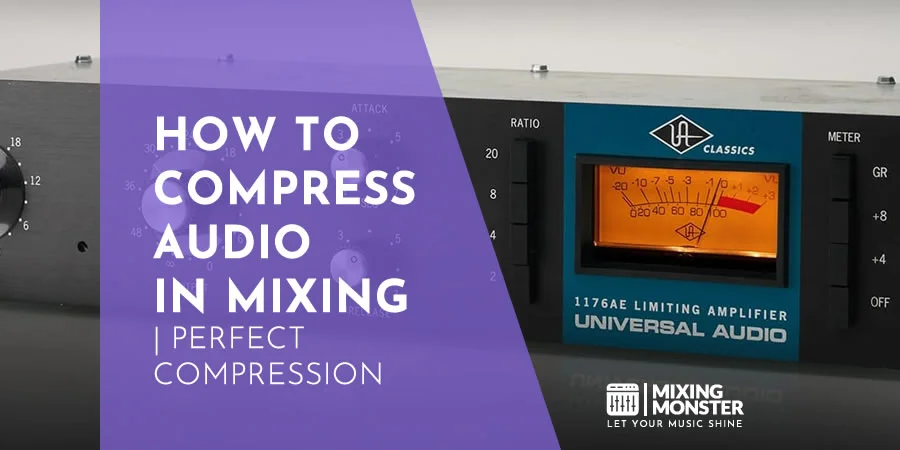
Mistake 3: Excessive Limiting
Similar to over-compression, excessive limiting robs your mix of dynamics. Keep limiting subtle to prevent a flat-sounding result, ensuring your final master retains its intended impact.
- Explanation:
Limiting is the final safeguard against clipping, but it squashes dynamic range when overused. - Consequences:
A loud but lifeless mix that tires the ears. - How To Avoid:
Apply limiting carefully during the mastering phase, not mixing. Aim for a balance between loudness and dynamic integrity.

Mistake 4: Too Much Or Not Enough Reverb
Reverb is a double-edged sword—a perfect amount can add depth, but overuse leads to a washy mix. Apply reverb carefully to enhance space without drowning clarity.
- Explanation:
Reverb creates space and depth, but incorrect amounts can bury elements in the mix or leave them dry and detached. - Consequences:
An unclear, muddy mix or one that needs more cohesion. - How To Avoid:
Use sends for shared reverb spaces and EQ reverb returns to fit the space around the mix elements. Balance wet and dry signals for a natural sound.

Mistake 5: Ignoring Timing And Tuning
Disregarding timing and tuning issues can make even a strong mix feel amateur. Address these problems in editing to present a coherent and professional-sounding mix.
- Explanation:
Timing discrepancies and out-of-tune notes disrupt the flow and professionalism of a mix. - Consequences:
A mix that feels sloppy and unprofessional. - How To Avoid:
Use editing tools to correct timing and pitch issues before mixing. Quantize with care and apply pitch correction transparently.
Mistake 6: Improper EQ Settings
Effective EQ balancing is pivotal for a clear mix. Cut or boost frequencies to shape your sound, but avoid extreme moves that could lead to an unnatural-sounding mix.
- Explanation:
EQ shapes the tonal balance of a mix, but excessive boosting or cutting can lead to phase issues and an unnatural sound. - Consequences:
A mix with muffled, harsh, or conflicting frequencies that lacks clarity. - How To Avoid:
Use subtractive EQ to remove unwanted frequencies before boosting. Employ surgical EQ for problem frequencies and broad strokes for tonal shaping. Always EQ in context with the whole mix, not in solo.
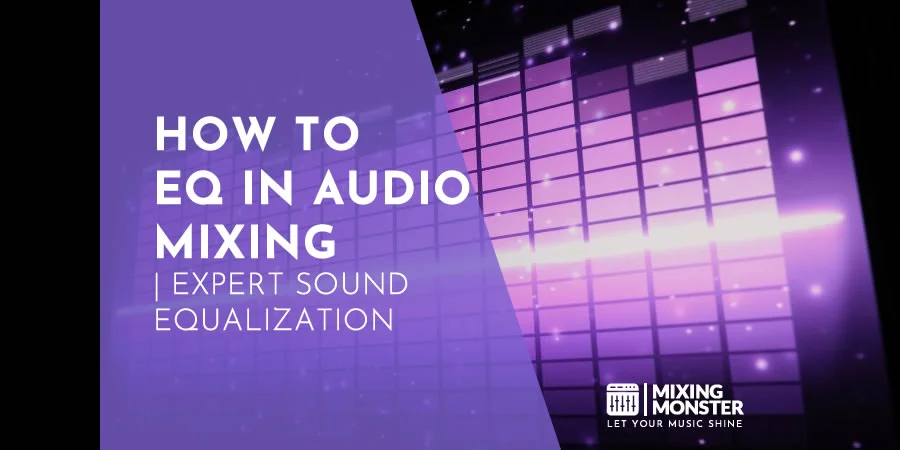
Mistake 7: Neglecting The Stereo Field And Panning
Creating space and depth in a mix is an essential task a mixing engineer must implement. Understanding the stereo field, audio panning, and problems like phase cancellations is important.
- Explanation:
Proper use of the stereo field helps create width and depth, allowing each element its own space. - Consequences:
A cluttered or flat mix where instruments compete for the same sonic space, leading to a lack of definition and impact. - How To Avoid:
Be strategic with panning. Use it to place elements in the mix so they complement rather than compete. Consider each instrument’s frequency content and role when deciding its position in the stereo field. Use tools like stereo imaging and binaural panning for a more immersive experience, but keep the core elements like bass, kick, snare, and lead vocals centered for a solid foundation.
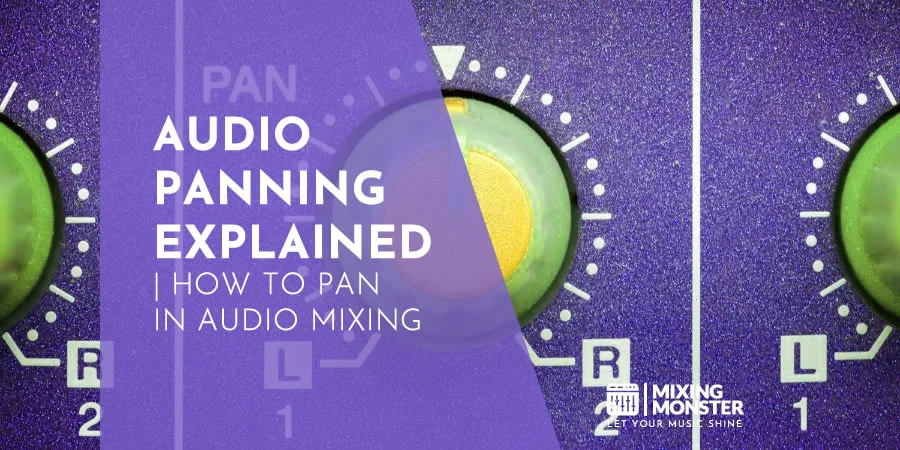
3. Best Practices For Avoiding Mixing Mistakes
In audio mixing, ensuring quality output involves more than just technical skills; it encompasses a comprehensive approach to the process. Implementing strong practices can prevent common errors that detract from the clarity and balance of your mix.
Monitoring Levels And Environment
Your mixing environment and monitoring levels are crucial. Make sure your listening space is acoustically treated to provide an accurate representation of sound. Monitoring levels that are too high or too low can deceive your ears, so aim for a moderate level for consistent judgment.
Reference Tracks
Use reference tracks to guide your mix. They serve as a roadmap, offering perspective on balance, EQ, and dynamics. Choose tracks well-mixed in your genre and continuously compare them to your work to maintain direction.
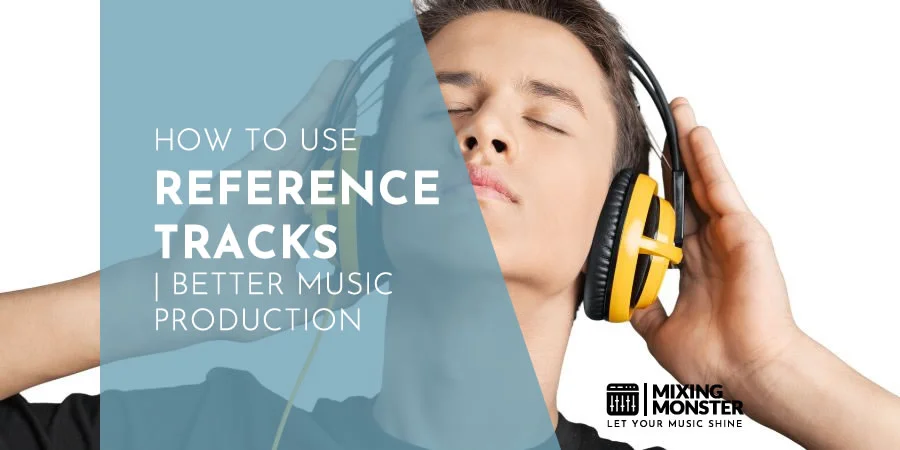
Gain Staging
Proper gain staging is fundamental in preserving audio quality. Keep levels in check to avoid clipping and ensure enough headroom. Stage your gains by:
- Setting appropriate levels for each track
- Checking for adequate headroom on buses and the master channel
- Adjusting faders rather than plugins for level changes
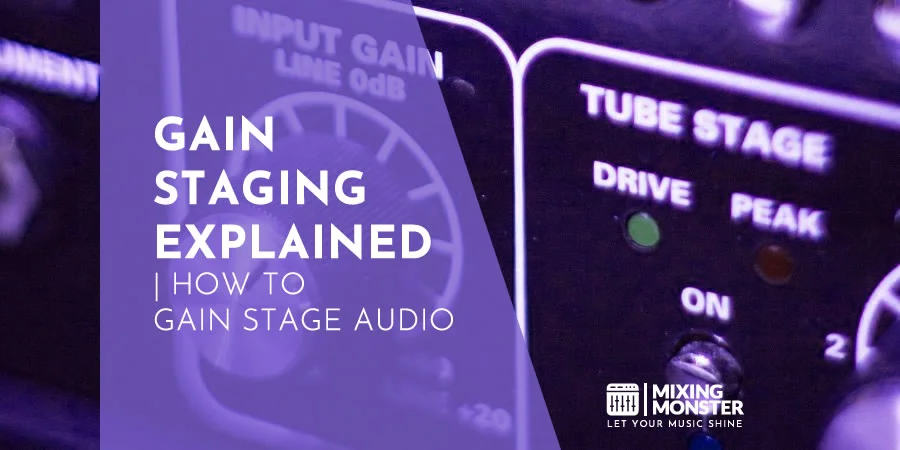
The Art Of Critical Listening
Develop your critical listening skills through practice and focused attention. Listen actively for frequency conflicts, stereo imaging, and dynamic range. Always take breaks to refresh your ears and return with a fresh perspective for a more accurate mix.
4. Correcting Audio Mixing Mistakes
This section will teach targeted strategies for identifying and resolving audio mixing errors. Whether you’re a novice or have some experience, understanding these methods will enhance your mixing workflow and help you achieve cleaner, more professional results.
Identifying And Analyzing Audio Mixing Mistakes
Your first step is to identify the specific mistakes in your mix. Listen critically and compare your track to a professional reference track to pinpoint areas for improvement. Use spectrum analyzers to identify issues like frequency masking or imbalances visually.
Step-By-Step Correction Methods
Moving methodically through the correction process is crucial to fix errors and avoid creating new ones. Here’s a straightforward table of common mixing mistakes and how to correct them:
| Mixing Mistake | Correction Method |
| Muddy Bass | Apply high-pass filters to non-bass elements |
| Harsh Vocals | Use de-essers and dynamic EQ to tame sibilance |
| Clashing Frequencies | Identify the critical frequencies and apply subtractive EQ to competing elements |
| Overcompression | Adjust the threshold and ratio settings or use parallel compression |
This approach reinforces the importance of patience and systematic work during correction.
When To Seek Professional Help
If you find yourself revisiting the same errors despite several attempts to correct them, consider professional help. Sometimes, a fresh set of ears and expert knowledge can illuminate problems you have missed and provide solutions that better fit your track.

5. Consequences Of Unaddressed Audio Mixing Mistakes
When mixing oversights persist without correction, they lead to a domino effect of unfavorable outcomes. Understanding the gravity of these consequences is essential for any aspiring professional in the music industry.
Impact On The Listening Experience
Poor mixing decisions can result in a flat or muddled listening experience. For instance, if depth is not effectively conveyed, your mixes may lack the three-dimensional quality that engages listeners. Errors in equalization could cause some instruments to be overpowering or others to be barely audible, disrupting the balance that is crucial for listener enjoyment.
Professional Repercussions
In the competitive field of audio production, the standard for audio quality is incredibly high. Substandard mixes can tarnish your reputation as a professional, limiting your opportunities for collaboration or employment. Clients and listeners may not trust your skills if common mistakes in your work are apparent, such as improper gain staging or excessive use of reverb.
Long-Term Effects On Audio Quality
Over time, repeated mixing mistakes can compound, leading to consistently disappointed audiences and fewer returning clients. A track with poor audio quality may suffer in mastering, becoming inadequate for commercial release. Your growth as a professional may be stunted without the benefit of positive feedback and a portfolio of crisp, clear mixes.
6. Future-Proofing Your Mixes
In an ever-evolving industry, future-proofing your mixes ensures that they remain relevant and high-quality. Keeping up with the latest trends and technologies, investing in continuous learning, and building a professional network is crucial for longevity in music production.
Staying Updated With Mixing Trends And Technologies
You should actively track and adopt new mixing trends and technologies to maintain a cutting-edge sound. Immersive audio formats are gaining traction, so consider how to integrate 3D audio techniques into your work. Regularly experiment with the latest plugins and software updates to stay ahead.
Continuous Learning And Skill Development
Engage in continuous learning and skill development to refine your mixing capabilities. Take advantage of online courses, attend workshops, and practice with new tools to expand your skill set. Prioritize mastering the fundamentals of mixing while exploring new genres and techniques to enhance your work.
Building A Network Of Professionals
Establishing a network of professionals is valuable for staying informed and connected. Join audio engineering communities, participate in forums, and attend industry events. Networking can lead to collaborations that introduce you to fresh perspectives and innovative approaches to mixing.
7. Stay On Track In Audio Mixing
Implementing best practices in audio mixing is crucial to the success of your production. You’ve learned about the common mistakes, such as neglecting gain staging or bypassing the use of reference tracks. Remember, mistakes are opportunities for improvement.
Practicing and sharing experiences will refine your mixing techniques. Make a deliberate effort to apply these insights to your work. It’s through consistent application that theoretical knowledge becomes practical expertise.
Consider this: revisit your mixes, analyze them with a critical ear, and apply the lessons learned. Your music will only benefit from your dedication to mastering the craft of audio mixing.
Happy mixing!
8. FAQ
1) What are the common pitfalls to avoid during audio mixing?
When you’re mixing audio, it’s essential to maintain balance across the frequency spectrum. Watch out for a muddy mix due to overemphasis on the low-end, and ensure you’re not making mixing decisions based on misleading room acoustics that can conceal crucial details.
2) How can I identify poor-quality mixes?
You’ll recognize poor-quality mixes by their lack of clarity and balance; individual instruments may need to be discernible. Listen for excessive reverb or compression, which can cloud the mix and cause frequencies to clash, obscuring the track’s details.
3) What are the best practices for mixing and mastering?
Best practices include careful gain staging and understanding EQ—whether to cut or boost frequencies. Retaining the dynamic range while ensuring your mix translates well across different playback systems is crucial when mastering.
4) What techniques should beginners focus on to improve their mixing skills?
If you’re starting, focus on learning how to EQ effectively to clean up your mix and create space for each element. Understand the basics of compression to control dynamics, and remember to check your mixes in mono to ensure compatibility across all playback systems.
5) Are there specific rules to adhere to when mixing music tracks?
While mixing is an art form with room for creativity, certain principles hold true. Keep levels consistent, use panning to create a wide stereo image, and avoid over-processing. Also, resist the urge to mix in isolation; instead, consider how elements work together in the mix as a whole.
6) How can one become proficient in the art of audio mixing?
Proficiency in mixing comes with practice and learning from experienced engineers. Engage with community forums, watch tutorials from trusted professionals, and, most importantly, mix regularly to hone your ear and develop your skill set.

